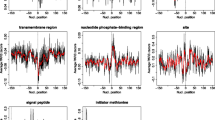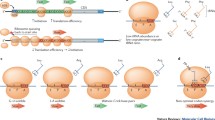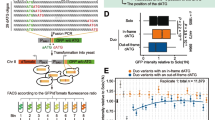Abstract
According to the scanning model, 40S ribosomal subunits initiate translation at the first (5′ proximal) AUG codon they encounter. However, if the first AUG is in a suboptimal context, it may not be recognized, and translation can then initiate at downstream AUG(s). In this way, a single RNA can produce several variant products. Earlier experiments suggested that some of these additional protein variants might be functionally important. We have analysed human mRNAs that have AUG triplets in 5′ untranslated regions and mRNAs in which the annotated translational start codon is located in a suboptimal context. It was found that 3% of human mRNAs have the potential to encode N-terminally extended variants of the annotated proteins and 12% could code for N-truncated variants. The predicted subcellular localizations of these protein variants were compared: 31% of the N-extended proteins and 30% of the N-truncated proteins were predicted to localize to subcellular compartments that differed from those targeted by the annotated protein forms. These results suggest that additional AUGs may frequently be exploited for the synthesis of proteins that possess novel functional properties.

Similar content being viewed by others
References
Bab I, Smith E, Gavish H, Attar-Namdar M, Chorev M, Chen YC, Muhlrad A, Birnbaum MJ, Stein G, Frenkel B (1999) Biosynthesis of osteogenic growth peptide via alternative translational initiation at AUG85 of histone H4 mRNA. J Biol Chem 274:14474–14481
Boeckmann B, Bairoch A, Apweiler R, Blatter MC, Estreicher A, Gasteiger E, Martin MJ, Michoud K, O’Donovan C, Phan I, Pilbout S, Schneider M (2003) The SWISS-PROT protein knowledgebase and its supplement TrEMBL in 2003. Nucleic Acids Res 31:365–370
Casadei R, Strippoli P, D’Addabbo P, Canaider S, Lenzi L, Vitale L, Giannone S, Frabetti F, Facchin F, Carinci P, Zannotti M (2003) mRNA 5′ region sequence incompleteness: a potential source of systematic errors in translation initiation codon assignment in human mRNAs. Gene 321:185–193
Emanuelsson O, Nielsen H, Brunak S, von Heijne G (2000) Predicting subcellular localization of proteins based on their N-terminal amino acid sequence. J Mol Biol 300:1005–1016
International Human Genome Sequencing Consortium (2004) Finishing the euchromatic sequence of the human genome. Nature 431:931–945
Kettman JR, Coleclough C, Frey JR, Lefkovits I (2002) Clonal proteomics: one gene–family of proteins. Proteomics 2:624–631
Kochetov AV (2005) AUG codons at the beginning of protein coding sequences are frequent in eukaryotic mRNAs with a suboptimal start codon context. Bioinformatics 21(7):837–840
Kochetov AV, Sarai A (2004) Translational polymorphism as a potential source of plant proteins variety in Arabidopsis thaliana. Bioinformatics 20:445–447
Kochetov AV, Ischenko IV, Vorobiev DG, Kel AE, Babenko VN, Kisselev LL, Kolchanov NA (1998) Eukaryotic mRNAs encoding abundant and scarce proteins are statistically dissimilar in many structural features. FEBS Lett 440:351–355
Kochetov AV, Kolchanov NA, Sarai A (2003) Interrelations between the efficiency of translation start sites and other sequence features of yeast mRNAs. Mol Genet Genomics 270:442–447
Kozak M (1994) Determinants of translation fidelity and efficiency in vertebrate mRNAs. Biochimie 76:815–821
Kozak M (1996) Interpreting cDNA sequences: some insights from studies on translation. Mamm Genome 7:563–574
Kozak M (2001) New ways of initiating translation in eukaryotes? Mol Cell Biol 21:1899–1907
Kozak M (2002) Pushing the limits of the scanning mechanism for initiation of translation. Gene 299:1–34
Larizza A, Makalowski W, Pesole G, Saccone C (2004) Evolutionary dynamics of mammalian mRNA untranslated regions by comparative analysis of orthologous human, artiodactyl and rodent gene pairs. Comput Chem 26:479–490
Liu Y, Liu XS, Wei L, Altman RB, Batzoglou S (2004) Eukaryotic regulatory element conservation analysis and identification using comparative genomics. Genome Res 14:451–458
Logette E, Wotawa A, Solier S, Desoche L, Solary E, Corcos L (2003) The human caspase-2 gene: alternative promoters, pre-mRNA splicing and AUG usage direct isoform-specific expression. Oncogene 22:935–946
Makalowski W, Boguski MS (1998) Evolutionary parameters of the transcribed mammalian genome: an analysis of 2,820 orthologous rodent and human sequences. Proc Natl Acad Sci USA 95:9407–9412
Meijer HA, Thomas AAM (2002) Control of eukaryotic protein synthesis by upstream open reading frames in the 5′-untranslated region of an mRNA. Biochem J 367:1–11
Meijer HA, Thomas AAM (2003) Ribosomes stalling on uORF1 in the Xenopus Cx41 5′ UTR inhibit downstream translation initiation. Nucleic Acids Res 31:3174–3184
Mignone F, Gissi C, Liuni S, Pesole G (2002) Untranslated regions of mRNAs. Genome Biol 3:3
Morris DR, Geballe AP (2000) Upstream open reading frames as regulators of mRNA translation. Mol Cell Biol 20:8635–8642
Oritani K, Hirota S, Nakagawa T, Takahashi I, Kawamoto S, Yamada M, Ishida N, Kadoya T, Tomiyama Y, Kincade PW, Matsuzawa Y (2003) T lymphocytes constitutively produce an interferon-like cytokine limitin characterized as a heat- and acid-stable and heparin-binding glycoprotein. Blood 101:178–185
Outten CE, Culotta VC (2004) Alternative start sites in the Saccharomyces cerevisiae GLR1 gene are responsible for mitochondrial and cytosolic isoforms of glutathione reductase. J Biol Chem 279:7785–7791
Oyama M, Itagaki C, Hata H, Suzuki Y, Izumi T, Natsume T, Isobe T, Sugano S (2004) Analysis of small human proteins reveals the translation of upstream open reading frames of mRNAs. Genome Res 14:2048–2052
Pedrajas JR, Porras P, Martinez-Galisteo E, Padilla CA, Miranda-Vizuete A, Barcena JA (2002) Two isoforms of Saccharomyces cerevisiae glutaredoxin 2 are expressed in vivo and localize to different subcellular compartments. Biochem J 364:617–623
Porcel BM, Delfour O, Castelli V, De Berardinis V, Friedlander L, Cruaud C, Ureta-Vidal A, Scarpelli C, Wincker P, Schachter V, Saurin W, Gyapay G, Salanoubat M, Weissenbach J (2004) Numerous novel annotations of the human genome sequence supported by a 5′-end-enriched cDNA collection. Genome Res 14:463–471
Remm M, Storm CEV, Sonnhammer ELL (2001) Automatic clustering of orthologs and in-paralogs from pairwise species comparisons. J Mol Biol 314:1041–1052
Rogozin IB, Kochetov AV, Kondrashov FA, Koonin EV, Milanezi L (2001) Presence of ATG triplets in 5′ untranslated regions of eukaryotic cDNAs correlates with a “weak” context of the start codon. Bioinformatics 17:890–900
Schneider R et al (2001) New ways of initiating translation in eukaryotes. Mol Cell Biol 21:8238–8246
Shabalina SA, Ogurtsov AY, Rogozin IB, Koonin EV, Lipman DJ (2004) Comparative analysis of orthologous eukaryotic mRNAs: potential hidden functional signals. Nucleic Acids Res 32:1774–1782
Suzuki Y, Ishihara D, Sasaki M, Makagawa H, Hata H, Tsunoda T, Watanabe M, Komatsu T, Ota T, Isogai T, Suyama A, Sugano S (2000) Statistical analysis of the 5′ untranslated region of human mRNA using “oligo-capped” cDNA libraries. Genomics 64:286–297
Tanaka A, Ueda M (2000) Sorting of peroxisomal and mitochondrial carnitine acetyltransferase isozymes in the diploid yeast, Candida tropicalis. Cell Biochem Biophys 32:139–146
Wang X-Q, Rothnagel JA (2004) 5′-untranslated regions with multiple upstream AUG codons can support low-level translation via leaky scanning and reinitiation. Nucleic Acids Res 32:1382–1391
Watanabe N, Che F-S, Iwano M, Takayama S, Yoshida S, Isogai A (2001) Dual targeting of spinach protoporphyrinogen oxidase II to mitochondria and chloroplasts by alternative use of two in-frame initiation codons. J Biol Chem 276:20474–20481
Acknowledgements
This work was supported by the Kyushu Institute of Technology 75th Commemoration Fund, Program of the Russian Academy of Sciences (Dynamics of Plant, Animal, and Human Gene Pools), the Russian Foundation for Basic Research (Grant No. 05-04-48207) and an RFBR-JSPS grant. We also thank the Siberian Division of the Russian Academy of Sciences (Complex Integration Program, Grant No. 59), and the Ministry of Industry, Science and Technologies of the Russian Federation (grant No. 2275.2003.4) for support.
Author information
Authors and Affiliations
Corresponding author
Additional information
Communicated by C. Hollenberg
Electronic Supplementary Material
Rights and permissions
About this article
Cite this article
Kochetov, A.V., Sarai, A., Rogozin, I.B. et al. The role of alternative translation start sites in the generation of human protein diversity. Mol Genet Genomics 273, 491–496 (2005). https://doi.org/10.1007/s00438-005-1152-7
Received:
Accepted:
Published:
Issue Date:
DOI: https://doi.org/10.1007/s00438-005-1152-7




